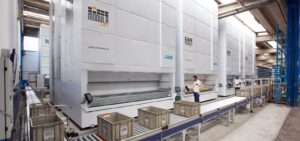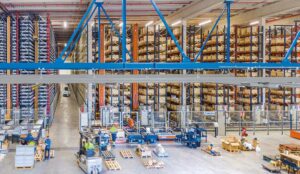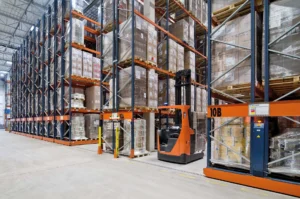Enhancing Warehouse Optimization
In the dynamic world of industrial manufacturing and warehousing, efficiency is the name of the game. The ability to move materials quickly and safely can significantly impact productivity and profitability. One indispensable tool that has been transforming industrial workflows is the material lift. Below we will discover the role of material lifts in industrial settings, exploring their benefits, applications, and why they are a crucial asset for any operation.
The Foundation of Efficiency
What Are Material Lifts?
Material lifts, also known as material handling lifts or hoists, are specialized machines designed to lift and move heavy or bulky materials within an industrial environment. They come in various configurations, including scissor lifts, boom lifts, and vertical mast lifts, each tailored to specific tasks and requirements.
These lifts are powered by electric, hydraulic, or pneumatic systems, making them versatile and adaptable to a wide range of applications. They are commonly used in manufacturing plants, warehouses, construction sites, and distribution centers, where the efficient movement of materials is essential.
Elevating Efficiency
1. Enhancing Safety
Safety is a top priority in any industrial setting, and material warehouse lifts play a crucial role in ensuring it. By mechanizing the lifting process, these devices reduce the risk of injuries associated with manual lifting and handling of heavy loads. Workers can operate material lifts from a safe distance, eliminating the need to be in close proximity to potentially hazardous materials.
2. Boosting Productivity
Industrial lifts significantly improve workflow efficiency. They can transport heavy loads quickly and effortlessly, allowing workers to focus on more critical tasks. With their precision and speed, these lifts contribute to reduced downtime, faster project completion, and increased overall productivity.
3. Versatile Applications
One of the standout features of these lifts is their versatility. These machines can handle various materials, from raw materials and equipment to finished products. They are equally adept at lifting objects to different heights and angles, making them suitable for a wide range of applications. Whether you need to load/unload materials from trucks, position equipment, or access hard-to-reach areas, lifts like these have got you covered.
4. Space Optimization
In crowded industrial settings, optimizing space is vital. Material lifts help maximize floor space by efficiently storing materials in vertical or elevated positions. This can lead to significant cost savings, as you may require less warehouse space or be able to use the available space more effectively.
5. Cost-Effective
While the initial investment in material lifts may seem significant, their long-term cost-effectiveness is undeniable. Reduced labor costs, fewer workplace injuries, and increased efficiency all contribute to a substantial return on investment. Additionally, the durability and longevity of these machines ensure they remain valuable assets for years to come.
Applications Across Industries
1. Manufacturing
In manufacturing facilities, lifts are indispensable for transporting raw materials to production lines and moving finished products to storage areas. Their ability to handle heavy loads and provide precise positioning makes them ideal for tasks like assembly, quality control, and maintenance.
2. Warehousing and Distribution
Material lifts are invaluable in warehouses and distribution centers, where they expedite the loading and unloading of goods. They help optimize storage space by stacking products efficiently and accessing high shelves with ease. This is especially important in the e-commerce era, where rapid order fulfillment is a competitive advantage.
3. Construction
Construction sites often involve working with bulky and heavy materials. Material lifts simplify the process of lifting and placing these materials, improving construction efficiency and safety. They are commonly used for tasks such as roofing, drywall installation, and equipment positioning.
4. Maintenance and Repairs
Industrial equipment and machinery often require maintenance and repairs at elevated heights or in hard-to-reach places. Lifts enable technicians to access these areas safely and efficiently, reducing downtime and ensuring equipment remains in optimal condition.
FAQ
What types of material lifts are available?
They come in various types, including scissor lifts, boom lifts, and vertical mast lifts. Each type is designed for specific tasks and requirements, with differences in lifting capacity and reach.
Are these lifts easy to operate?
Yes, material lifts are designed to be user-friendly. They typically feature intuitive controls, and operators receive training to ensure safe and efficient operation.
How do material lifts contribute to workplace safety?
Material lifts reduce the risk of injuries associated with manual lifting and handling of heavy loads. Workers can operate these machines from a safe distance, minimizing exposure to potential hazards.
Can material lifts be used outdoors?
Yes, many material lifts are designed for outdoor use. They are equipped with rugged components and weather-resistant features to withstand various environmental conditions.
Are these lifts cost-effective in the long run?
Absolutely. While the initial investment may be significant, material lifts provide a substantial return on investment over time. Reduced labor costs, increased efficiency, and fewer workplace injuries contribute to their cost-effectiveness.
In Conclusion
Exceptional lifts like these are pivotal in enhancing efficiency and safety across various industrial sectors. Their ability to handle heavy materials, optimize workspace, and reduce operational costs makes them a valuable asset for any organization looking to streamline its workflow. Whether you’re in manufacturing, warehousing, construction, or maintenance, incorporating material lifts into your operations can lead to remarkable improvements in productivity and profitability.






